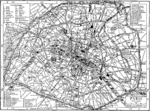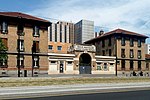Stade Bauer
1909 establishments in FranceFootball venues in FranceOlympic football venuesRed Star F.C.Sports venues completed in 1909 ... and 2 more
Sports venues in Seine-Saint-DenisVenues of the 1924 Summer Olympics

The Stade Bauer (also called the Stade de Paris) is a 10,000-capacity football stadium in Saint-Ouen-sur-Seine in the northern suburbs of Paris. The stadium is mainly used by Red Star F.C. who currently play in Championnat National but have tasted success in the Coupe de France, winning it on five occasions (1921, 1922, 1923, 1928, 1942).
Excerpt from the Wikipedia article Stade Bauer (License: CC BY-SA 3.0, Authors, Images).Stade Bauer
Parvis du Stade, Saint-Denis
Geographical coordinates (GPS) Address External links Nearby Places Show on map
Geographical coordinates (GPS)
| Latitude | Longitude |
|---|---|
| N 48.905833333333 ° | E 2.3408333333333 ° |
Address
Stade Bauer (Stade de Paris)
Parvis du Stade
93400 Saint-Denis
Ile-de-France, France
Open on Google Maps










